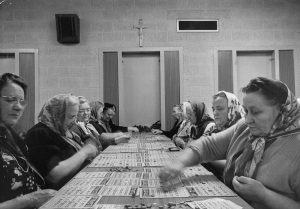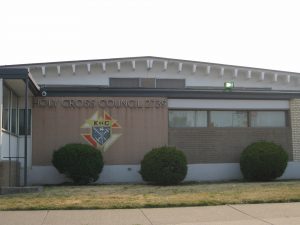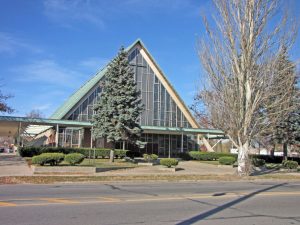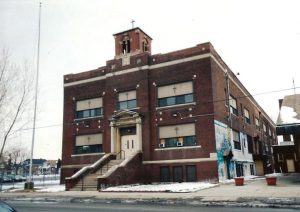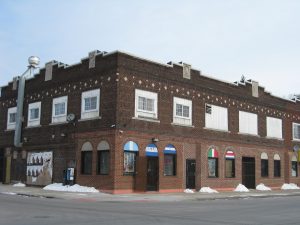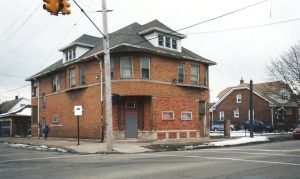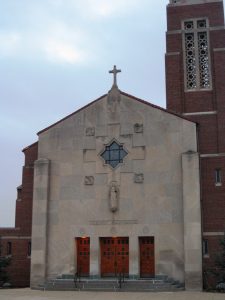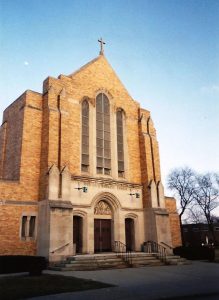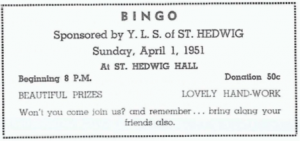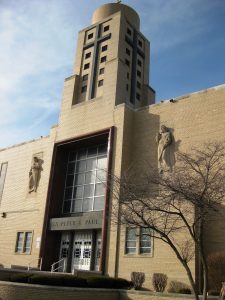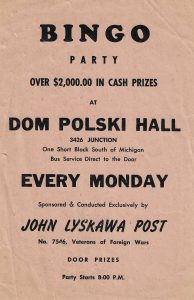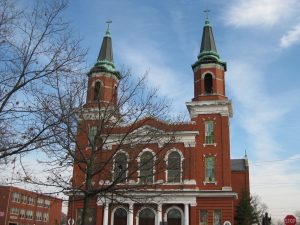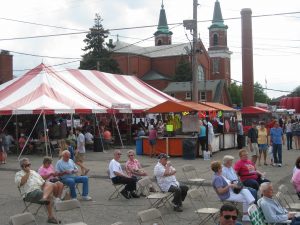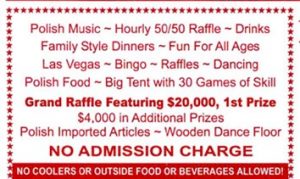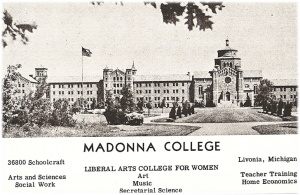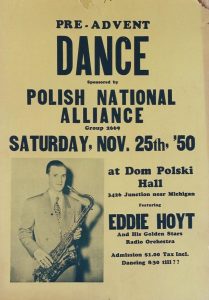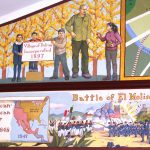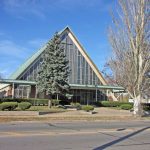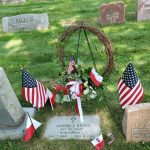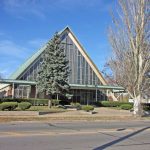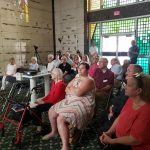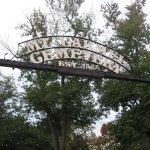Bingo!
A Mainstay in West Side Detroit’s Polish American Catholic Parishes and Fraternal Organizations
The game of bingo is known to just about everyone, particularly Polish Americans and older individuals. While there may be a tendency to associate bingo with Polish Americans, the elderly, and even Catholic churches, the game of bingo has a long, multi-cultural, religion-spanning, and evolutionary history. However, the game has endured and has remained extremely popular to this day in many Polish American Catholic communities.
For decades, Polish American Catholic parishes, Catholic fraternal organizations, and even Catholic colleges have hosted bingo parties and events. This is a phenomenon that has been consistent throughout the United States. Notwithstanding bingo’s long history, within large North American cities, including Detroit’s west side Polish American community, the heaviest concentration of bingo events during the 1920s through the 1980s was generally in the heart of the community, i.e., where the largest population of Polish Americans were found. But the game originated long before these communities were formed.
Bingo dates back to at least the 1700s. According to many sources, bingo originated in Italy during the Renaissance. The game is also closely tied to the lottery, or lotto, a form of gambling in which players win random prizes. In fact, it is generally agreed that bingo during the Italian Renaissance was called Il Gioco del Lotto d’Italia (“the Italian Lottery Game”), a form of lottery that dates back to 1530.
Bingo migrated to France during the 18th century, where it was known as Le Lotto, and where it became extremely appealing and popular among the aristocracy. During the 19th century, the game made its way to Germany, where it was transformed and employed for educational purposes.
North America embraced bingo during the early 20th century under the name beano, which was derived from the beans that were used to mark numbers on cards. The numbers were drawn from a cigar box and called out by a number caller, as they are today. The game was very popular at carnivals. It became known as bingo by accident when a player blurted out a cry of “Bingo!” instead of “Beano!” and the name stuck.
At some carnivals and festivals in the early 20th century, kernels of corn were used as markers on bingo cards. This practice continued at later block parties in some North American cities in the 1950s and 1960s.
Edwin S. Lowe (1910 – February 23, 1986), a Polish American toy merchant and visionary and the son of Jewish Polish immigrants, and Carl Leffler, a Columbia University mathematician, are credited with enhancing the game and producing a rendition essentially the same as the one used today. Lowe was born in Poland and went on to develop real estate and to create a toy dynasty that included the creation of plastic toys and the dice game Yahtzee. Later in life he was involved in the film and stage production industries. It is worth noting that in 1973, Lowe’s company was sold to Milton Bradley for $26 million.
Lowe became intrigued by the game of bingo when he saw it being played at a carnival near Atlanta, Georgia, in December of 1929, where it is said the game was first played in North America. Seeing what he believed to be a unique opportunity for commercialization, Lowe, who at the time was living in New York, produced two versions of the game, a 12-card set for $1 and a 24-card set for $2.
The game’s concept is relatively simple. Players purchase or donate money for a small cardboard card on which 24 numbers are printed within a grid, with a “free” space marked in the middle of the card. Across the top row of numbers, the letters B-I-N-G-O are printed. A caller pulls combinations of letters and numbers from a cage (today, this is usually done electronically) and calls them; e.g., B-12, N-45, G-54, etc. Players mark off their letter-number combinations using various methods. On some cards, small, transparent, window-shade-looking pieces of plastic are built into the cards and can be drawn down over each letter-number combination as they are called. In other versions, small plastic, cardboard, or cork tokens are used to cover the number-letter combinations. When a row is filled (which can be a full row down, across, or diagonally, depending on the particular game’s rules), the player shouts “Bingo!” and wins the prize for that game.
Bingo’s popularity in America exploded during the Great Depression years from 1929 to 1933, and it was during this period that the game became extremely appealing to and intertwined with Polish Americans and Catholicism. It was a Catholic priest in Wilkes-Barre, Pennsylvania, who is credited with pioneering bingo events within the Catholic Church and using the events for fundraisers. Recognizing bingo as a means of financing his parish’s school, the priest bought several sets of the game and introduced it to his parishioners. The only downside was that the games contained multiple copies of the same cards containing the same numbers. Thus, each time “Bingo!” was called, the priest had to give out multiple prizes.
The priest approached Lowe with this dilemma. Lowe in turn hired the mathematician Leffler, whose assignment was to increase the number of non-repeating combinations of card numbers so that there would not be as many duplicate winners. Leffler evidently came through because by 1930, he had created 6,000 different combinations of bingo cards. Some sources state that Leffler later went insane.
It is estimated that by 1934, approximately 10,000 bingo games a week were being played throughout North America. Bingo became predominantly, but not exclusively, a female game. There were many men who enjoyed (and who still enjoy) playing bingo.
While bingo playing was not limited to Polish Americans or Catholics, there appears to be a direct correlation between bingo’s popularity and the large concentration of Polish American Catholics dwelling in a particular area. For example, as of 2017, “Cheektowaga, New York, with one bingo hall for every 6,800 residents, is believed to have the highest concentration of bingo halls in the United States. The suburb of Buffalo’s large Polish-American Catholic population is thought to be a factor in bingo’s significant popularity in Western New York, which has five times as many bingo halls per capita as the rest of the state.” 1/
The phenomenon of high concentrations of bingo halls and bingo playing in general vis-à-vis Polish American Catholic populations in North American cities is well documented. The aforementioned priest from Wilkes-Barre, Pennsylvania, is said not only to have saved his parish school, but also to have spread the news about the game to a failing Knights of Columbus hall in Utica, New York, which was also saved by the proceeds made from bingo. Bingo’s popularity spread like wildfire across North America and became increasingly popular in Polish Catholic churches and communities, where its communal and fraternal aspects, as well as its use as a fundraising measure, complimented these intimate, benevolent, and church-oriented populations perfectly.
This has not been without some tension and controversy throughout the years, however, since playing bingo has been viewed by some as engaging in gambling. Thus, the Church in various states, at various times, has taken differing positions on the subject. But generally speaking, the key to approving bingo within the religious sector seems to reside in strict compliance with state and local regulations and its focus on charity.
For decades in Michigan, bingo games were unregulated. In the 1970s, the State Lottery Commission began regulating the game as a form of the lottery. According to Rev. Canon Walter J. Ptak, West Side Detroit Polish American Historical Society director and pastor of Our Lady of Sorrows Catholic Church in Farmington and former pastor of Our Lady of Mt. Carmel Catholic Church in Wyandotte (now Our Lady of the Scapular), “they had to have detailed record keeping. It became a real production to have one bingo night.” 2/
In New York City, bingo was on and then off again for several years, from 1938 to the mid-1940s, depending on who held office and what the views were on this game of chance. In 1938, Mayor Fiorello LaGuardia put a temporary ban on bingo out of fear that criminals would “turn it into a racket.” 3/ That was reversed a few years later, however, when the New York State Legislature passed a law allowing bingo, provided it was played in a church or synagogue, and provided that the proceeds benefited a charitable cause. But in 1942, the Archdiocese of New York prohibited all bingo games within its borders. Yet again, that decision was rescinded a few years later.
State laws vary with regard to the regulation and playing of bingo, and 10 states do not allow it at all as a commercial enterprise. But since 2011, bingo has been legal at the federal level. It is worth noting that the 10 states that do not allow bingo to be played commercially still approve it as a fundraiser.
Although bingo has been played in synagogues and in Christian churches throughout the years to raise funds for various causes, it is without a doubt a major event in Catholic churches, and in particular in Polish Catholic churches across the country. It also has been an extremely important activity for the Knights of Columbus councils and other fraternal organizations, both nationwide and in Detroit. Although its popularity is not what it was in the 1940s or even the 1970s due to an aging population and a rise in the popularity of other activities such as the card game Euchre, bingo is still highly popular in metropolitan Detroit’s Catholic churches and religious organizations. According to one source, within the Archdiocese of Detroit, as of 2016 there were 30 bingo games registered with the State of Michigan. Thirteen of them were sponsored by a parish or school, and 17 were sponsored by a Knights of Columbus council.
Within Detroit’s west side Polonia, when bingo made its debut and was at its peak in popularity, generally speaking, it appears to have been the most heavily concentrated in parishes that were in the heart of the community. For example, the parishes within Southwest Detroit’s Polonia and Wyandotte’s Polonia hosted many bingo events each week, as did the Holy Cross Council No. 2739 Knights of Columbus Hall at 4381 Larkins Street, south of Michigan Avenue. These events went on for years and drew large crowds of people, not only from the parishes and the Council, but also from surrounding neighborhoods and the suburbs.
The West Side Detroit Polish American Historical Society’s president, Rev. Gary Michalik, grew up as a parishioner at St. Andrew Catholic Church at 7060 McGraw at Cecil in the heart of Detroit’s west side Polonia, and also went all through school there. In an interview, he described his days of volunteering at the Wednesday and Saturday evening bingos there during the late 1970s and 1980s, when the events drew at least 250 people.
Wednesday night’s bingos were held in the social hall in the lower level of the two-story St. Andrew Gymnasium, where there was a kitchen. Locker rooms were also located in the lower level. A basketball court, bleachers, stage, and dressing rooms were located in the gymnasium’s upper level.
The Saturday evening bingos were initially held in the lower level social hall of the gymnasium. But the Saturday night games became so popular and heavily attended that eventually, they expanded to both the lower and upper levels of the gymnasium, where they were played simultaneously on both levels. Attendees at the Saturday night bingos eventually outnumbered those at the Wednesday night games.
The proceeds from the Wednesday night bingos benefited the parish’s general fund. The proceeds from the Saturday night bingos went to the high school athletic fund and may also have gone at times to the elementary school fund.
According to Fr. Gary, the social aspect of bingo was undeniable. “Just as Polish people had a liking for bowling, so too were they drawn to bingo.” But the bingo events became a crucial element of parish life because the proceeds also generated income for the parish. As Fr. Gary put it, “The monetary prizes were a big part of every parish’s income.”
Fr. Gary added, “Bingo was also important to the individual parish societies, such as the Altar Society and the Rosary Society. When they had meetings, for entertainment they would play a game of bingo. . . . Playing a game of bingo was just a way of passing the time.”
Some organizations played a game of bunco, according to Fr. Gary. “You played cards or bingo or bunco. It was a way of socializing. On Saturday night, you went to bingo.”
At the bingos, they would sell basic things like hot dogs, pizza, chips, and pop. In addition to the food, they sold what were known as “rip-offs,” or small lottery tickets provided by the Michigan Lottery. They were popular at parish festivals and at bingos. Parishioner volunteers would work and sell the food, which would also benefit the fund.
But make no mistake about it, bingo events were also a lot of hard work. According to Fr. Gary, “With every bingo, you needed 12 to 15 people volunteering. You needed people to manage the door, sell the cards and bingo supplies, walk the floor, a caller to call the numbers, and someone to man the kitchen. At a lot of places, either the school closed or it was getting increasingly difficult to get volunteers to work the bingo. If bingo started at 6 or 7 o’clock, someone had to be there two, three, or four hours earlier to set things up. They had to set up the cards and get the kitchen food ready. They stayed until 10:30.
“Most of the volunteers were senior citizens. Most got tired. Most arrived by 5 or 6 o’clock and stayed until 10:30.” Such was their love of bingo—and their parish. It was worth it because the parishioners and other players knew that they were donating to the church.”
It was all worth it for the socialization and for the benefits that the parish derived. But the prizes were good, too. According to Fr. Gary, bingo was fun because you could win prizes. At that time, the State Lottery Commission regulated bingo, and the prizes were regulated by the Commission. According to Fr. Gary, “The first bingo of the game would be maybe $50. The second bingo would be maybe $25 or $35. If there were more than one bingo, you had to split the $50.”
“Then there were ‘specials’ where you dabbed your numbers with large Magic Markers. For the specials, you would have to get numbers on four corners, around the border, cover-all, etc. The prize for the cover-all would be $250 to $300.
“Some places had progressive bingo. There were 75 numbers in bingo. If you got a cover-all with 55 numbers, then you won the prize. If no one got the bingo with 55 numbers, then the next week you had to get the bingo with 60 numbers, and the prize number went up every week as an incentive for more people to buy bingo cards.”
Players would purchase the cards for X amount of money per card. For example, 3 cards for $1. They would get one admission card, and then if they wanted additional cards, they could get 3 for $1, for example. If you didn’t like the numbers on your cards, you could exchange them for different cards. Some people who played bingo were highly superstitious and fervently believed in luck. They would bring good luck charms with them to bingo, such as “little animals or jewelry.” 4/
Bingo games attracted all kinds of people. “Friends, neighbors, and relatives” went to the games, according to Fr. Gary. And some of them were fanatical about the game. “Some people would have 25 cards in front of them. As bingo numbers were called, eventually they knew the numbers that were on all their cards. They didn’t use the covers anymore. They had a photographic memory of all their bingo numbers.”
Fr. Gary also had experience as a bingo caller. “When you called back the numbers, such as B-7 or I-16, you couldn’t do it too slow or too fast. Sometimes, people would yell at the caller, ‘Slow down,’ or ‘Hurry up!’ If they felt you as the caller were calling the same number, they would yell, ‘Shake them up!’ We used an electronic machine with forced air that moved the balls around. One ball would show up at a time and put it on the caller’s board, and the players could also see it.”
Bingo lasted at St. Andrew until the late 1980s—possibly until 1988 when the high school closed. The Wednesday night bingos may have lasted a bit longer than the Saturday night bingos.
St. Andrew Catholic Church, founded in November of 1920, was demolished in June of 2021.
In 1987, Fr. Gary became pastor of St. Stephen Catholic Church (later St. Stephen/Mary, Mother of the Church and now Our Lady of Guadelupe) at 4329 Central at St. John Street. There, bingos were still going strong and were held weekly on Wednesday evenings with the proceeds benefiting the general fund. At that time, the bingos drew between 125 and 150 people, if not more. Fr. Gary was there most Wednesdays to call the numbers, work the floor, and call back the bingos.
As much fun as bingo was, and as much as it benefited the parishes, there was a draw-back to all this bingo playing. In the early days, smoking was allowed at the bingos, just as it was in all public places. Fr. Gary stated, “You would walk in, and after a while, you would see a layer of smoke in the bingo hall. Then, in the later days, they came up with the smoking section and non-smoking section, but they were in the same room. You would just reek of cigarette smoke when you left. You had to wash your clothes when you got home.”
Society member Frank Urbiel also recalled the smoke-filled bingo hall at St. Stephen during the 1970s and early 1980s. Frank, who grew up in the parish of Our Lady Queen of Angels at 4200 Martin Street, south of Michigan Avenue, also in the heart of west side Detroit’s Polonia, joined St. Stephen parish—his wife Judy’s church—when they married in 1975. Judy is also a Society member, and she and Frank both worked the bingos for the Parent-Teacher’s Organization at St. Stephen back then. Frank recalled, “I just remember coming home smelling of cigarettes because a lot of people smoked—a lot.”
But bingo wasn’t over when you left the hall, according to Fr. Gary.
“After you cleaned up and locked up, many times the volunteers would go to the local bar and have drinks,” according to Fr. Gary. At. St. Andrew, Keno Bar on McGraw and Tarnow was the place we would gather. At St. Stephen, Michno’s Bar on Central was where we would go, as that was St. Stephen’s parish bar. After working bingo, you were all wound up and too excited to go to bed. You would often go to the bar for an hour or so for drinks to wind down.”
There were also special bingo events. Feather parties were “special bingos,” according to Fr. Gary. St. Stephen held a feather party on the weekend before Thanksgiving when he served as pastor there. At feather parties, the first prize was a turkey, and the second prize was a chicken. Proceeds from the St. Stephen feather parties benefited the sisters’ convent. For example, if the sisters needed new drapes, a new washing machine, or a new stove or refrigerator, the proceeds paid for it.
The feather party tradition is a very old one in the Polish American culture. St. Barbara Catholic Church at 13534 Colson Street in Dearborn has a record of its first annual feather party, which was held in the old Schaefer Hall on December 22, 1924. The old Schaefer Hall was in a building owned by local Dearborn resident John Schaefer and donated as a temporary headquarters for the use of the parish until a new church was built.
Bingo was also extremely popular at St. Barbara parish and dates back to the World War II years, when bingos were held as fundraisers. The St. Barbara Young Men’s Usher’s Club organized a Servicemen’s Club, which held a bingo on January 21, 1945, at which some participants gave tokens of remembrance or thanksgiving for a family member’s recovery from war wounds or for a safe return home.
Bingo events at St. Barbara were sponsored by various parish societies, such as the Altar Society, which sponsored a bingo in May of 1949 to help with the $163,000 needed to pay for a new sisters’ convent to house 16 nuns. Along with bowling, bingo’s popularity reached an all-time high at St. Barbara in the 1949-1950 time frame. In 1950, games were held every Monday night at 8 p.m. in the Parish Hall. However, by the following year, all bingo games were halted by order of Dearborn’s police department.
At Our Lady Queen of Angels on Martin, bingo was big, according to Frank Urbiel and also Honorary Society Member Steve Isaacson. Both Frank’s mother and his busia attended bingo there for years, and Frank, who grew up in the parish in the 1950s, recalled that “it was always crowded, and the ushers (my dad included) used to call numbers and do all the prep and cleanup.”
Steve Isaacson recalled that Queen of Angels held bingo events “for years.” Steve also remembered from living in the neighborhood that the Holy Cross Council No. 2739 Knights of Columbus Hall at 4381 Larkins Street, south of Michigan Avenue, had bingo “for years.” Long-time Society member and former treasurer Bob Bielenda has ties to both St. Hedwig Catholic Church at 3245 Junction, south of Michigan Avenue (the Society’s first headquarters), and the Holy Cross Council, where he is a Fourth Degree Knight. Bob worked the bingos at Holy Cross from 2000 until approximately 2011. The history of bingo events dates back many years at the hall, which closed permanently in approximately 2020.
Bingos were held twice a week at the hall when Bob worked them. The Fourth Degree Knights sponsored the Friday night bingos, and another organization sponsored bingo on a different night during the week. Bob stated that there were between 100 and 120 attendees for the Friday night bingos. Proceeds benefited the general fund. A man came in and cooked hamburgers, which were sold as refreshments.
They also sold “rip-off” tickets. Winners of the “rip-offs” could take home anywhere from $1 to $100 per ticket in prize money.
People from all over the neighborhood went to the Holy Cross Council’s Friday night bingos. The games also drew people from the surrounding suburbs. According to Bob, “Bingo was a good way to raise money.”
Bingo was popular at St. Hedwig parish in the 1950s, and Bob also recalled the feather parties that were held at the parish in the 1940s, when he was in the 8th Grade. The feather parties were held in the parish hall before Thanksgiving and before Easter. The prize for Thanksgiving was a turkey, and the prize for Easter was a chicken.
In west side Detroit’s Warrendale district, at Ss. Peter & Paul Catholic Church located at 7685 Grandville Avenue between W. Warren Avenue and Tireman Street, west of Southfield Road, bingo was also extremely popular during the early to middle part of the 20th century. It may have been at its peak in popularity during the period from the 1950s to the 1980s. According to Society Director Donna (Kutylowski) Czeski, whose ancestors were long-time Ss. Peter & Paul parishioners, proceeds from the bingo events most likely benefited the parish or school. Bingo was also played at the church festivals years ago. There was a separate, designated area of the festival for bingo, such as a tent or perhaps the church’s Activities Building.
At the Dom Polski at 3426 Junction, the social and cultural hub of Detroit’s west side Polonia from the early 20th century through the 1960s, bingo parties were all the rage during the 1940s. The Pvt. John Lyskawa V.F.W. Post No. 7546 at 6828 N. Waverly Street in Dearborn Hts. sponsored the events, which were held every Monday night, and even offered free door-to-door bus service. Over $2,000 in cash prizes were given away at the parties.
Bingo events held in the churches and fraternal halls of west side Detroit’s Polonia were mimicked in Wyandotte, a downriver community that attracted a large Polish American population in the late 1800s and which remained predominantly Polish American for decades. Society Director Rev. Canon Walter J. Ptak, who grew up in Wyandotte and whose ancestors had strong roots in the community, served as pastor of Our Lady of Mt. Carmel Catholic Church at 976 Pope John Paul II Avenue in Wyandotte for 21 years, from July of 1992 to July of 2013. He is now pastor of Our Lady of Sorrows Catholic Church in Farmington. Bingo was a huge and important event at Our Lady of Mt. Carmel.
According to Fr. Ptak, bingo was established at Our Lady of Mt. Carmel in the 1940s. When he was pastor there, bingo was held weekly on Thursday nights and was sponsored by the Friends of the Comets (the name of the athletics), and it raised money for the athletics. The Friends of the Comets was made up of ushers and members of the Holy Name Society, but they were organized on their own and had their own tax I.D. number.
Bingo was also held at the ladies’ social events in the spring and fall. Those events continued for over 60 years.
Bingo was first held in the parish hall, and then later the bingos were relocated to the Polish Roman Catholic Union of America #162, or PRCU, at 1430 Oak Street in Wyandotte, when their hall was built. Bingo continued at the PRCU until sometime around 2000 when lottery games became more popular.
Bingo was never held on Holy Thursday during Holy Week or on Thanksgiving. “But for 50 weeks out of the year, people would play,” said Fr. Ptak. And the bingos were enormous. “In the earlier days, they would probably have 250 to 300 people. They would play 10, 12, or 15 cards. A person would pull the numbers out of a drum.”
The kitchen served concessions, such as hot dogs, sandwiches, soft drinks, and chips, which required labor. According to Fr. Ptak, “Girls from the high school had to run the tables for the refreshments.”
Players bought their cards, and the winners received cash prizes. The proceeds were derived from the bingo cards that the players purchased. At the end of the night, after paying the expenses such as hall rental and a small token for the workers, the remaining income benefited the athletics.
According to one source, in 1967, bingos were being held at the PRCU on Oak Street on Monday, Wednesday, Thursday, and Friday nights. Players paid $1 for five regular cards, 50 cents for a door card, and 25 cents for four special cards, and four or five special games were held each night.
Bingo was also extremely popular at the annual Polish festival at Mt. Carmel, which was initiated in the ‘30s or ‘40s. It ended in the early ‘50s, according to Fr. Ptak, but was revived in 1973 by Fr. Stan Redwick and has continued since then. The huge bingo tent held about 200 comfortably, and bingo ran all day long on Saturday and Sunday throughout the duration of the festival. According to Fr. Ptak, most people played approximately four cards simultaneously. Proceeds from the festival bingos benefited both schools and helped with parish upkeep. Occasionally, the proceeds would be earmarked for a specific purpose, such as painting of the church.
Bingo at Our Lady of Mt. Carmel was extremely beneficial. “I remember the days when they would turn over $40,000 to $50,000 a year to supplement the athletic program,” said Fr. Ptak. But as time went on, there were fewer nuns in the schools, and they were replaced by lay teachers. Parish life began to change.
In addition, bingo was negatively impacted by tear-off lottery tickets, which the State introduced and allowed to be sold at the festivals. At that time, according to Fr. Ptak, everything was highly regulated, and the money that was made on the tear-off lotto tickets “didn’t quite make up for what was lost from the bingos.”
When he was young, in the 1960s, Fr. Ptak’s mother, as well as all his aunts, went to bingo all the time. “That was what they did,” he said. But later, while raising six children, his mother “didn’t always have the time. My sisters were always working the festival. My mother worked the festival, too,” he said.
“My grandmother was a huge bingo addict,” Fr. Ptak added. “She had all these lucky charms that she would put on the table.”
In 1967, bingo games were also being played once a week at the Polish Legion of American Veterans Post No. 7, at the time located at 448 Ford Avenue in Wyandotte. The games drew approximately 200 players, and jackpots ranged from $300 to $500.
In Detroit’s downriver area at that time, one could find a bingo game any night during the week. Devoted players spent about $40 per week on bingo, played as many as 15 cards at a time, and surrounded themselves with their lucky charms. Tiny troll dolls seemed to be one of the more popular amulets of the time.
The proceeds from these organizations’ bingo games, which ranged from $10,000 to $12,000 per year, were used toward their halls’ mortgages and for hall maintenance. Some of the proceeds were donated to charity. For example, a portion of the PRCU’s proceeds in 1967 went to the March of Dimes.
Some downriver Catholic parishes at that time derived their biggest source of income from proceeds from bingo.
When asked why bingo is so appealing to Polish Catholics, Fr. Ptak’s answer was simple. “There’s a little something in it for them, and there’s something in it for the church.”
Fr. Gary agreed. Besides being a tremendous benefit to the church, “bingo was socializing, catching up on the latest family and neighborhood news. You got together with your kumoszki (close women friends) and caught up on everything.”
Even the Felician Sisters got in on bingo. Steve Isaacson recalled, “Now I DO remember Madonna University having bingo when it was still Madonna College, and I’m just old enough to remember that they also had a festival there, or a bazaar that the nuns put on, and they also used to have a killer craft show usually in the fall, if I remember correctly. All that ended years ago from what it seems.”
Today, bingo remains enormously popular throughout Europe as well as worldwide. It is especially popular in Germany, Sweden, Denmark, Romania, Russia, and Japan. But the “undisputed bingo capital of Europe” is the United Kingdom. Bingo was introduced to the UK from American in the 1950s, and since then, the UK has been enamored with “American bingo.” This love of bingo in the UK is most evident in London. Other bingo hotspots are Rome and Moscow. 5/
In North America today, bingo does not seem to be losing too much ground, as it is estimated that $90 million per week is spent on bingo tickets. 6/
Like Polish American polka dances, throughout the years, bingo was a social event that was tied to the local parish. In the early to mid-20th century, especially within the tight-knit Polish American neighborhoods, the neighborhood parish was the focal point of daily life. Parishioners went to church to worship, to support the parish and its schools, and to bond with one another.
At that time, along with churches, west side Detroit’s Polish American neighborhoods were filled with dance halls. It was the era of live music, which was featured in clubs and bars four nights a week. Often, a local storefront was converted to a dance hall to accommodate the considerable number of dances that were held on weekends. Those events always featured live bands, and dances had catchy names that were associated with the season, an upcoming holiday, or the time of year, such as Snowball Dance, Fall Frolic, May Hop, and the like.
There were also special dances tied to liturgical celebrations, such as Pre-Advent and Pre-Lent dances, or Pączkowy Balls, and dances for events honoring a person, such as the Queen of Dom Polski. These dance names illustrate the close ties between the community, entertainment, daily life, and the church. They were nearly indistinguishable. In fact, sponsoring organizations often threw dances for no special reason, just to bring people together. These dances, often called by such names as Friendship Dance, Spring Polka Frolic, Fall Jamboree, Pre-Holiday Polka Frolic, and similar names, were always held as fundraisers to raise money for a particular organization, church society, or special need. Thus, like bingo, the dances served a dual purpose.
Like the dances of yesterday, bingo events were fundraisers. Polish American Catholic churches and Catholic fraternal organizations used bingo as a means of raising money for their parishes, parish schools, athletics departments, fraternities, or other special needs. But they were more than that. Like dances, bingo events were a means of drawing families and members of the parish and community together. And that is something that is sorely lacking today.
Bingo is one of those rare and timeless phenomena that has lasted centuries, spanned continents, cultures, and religions, and which attracts young and old alike. It is a game of chance but also a game of community, which makes it universally appealing. Its simplicity and focus on fellowship elicits a large following. It has been played in bingo halls and bingo tents at festivals, in social halls, at community centers, bazaars, and even in church parking lots. People have played bingo throughout the years while training at military academies and while convalescing in nursing homes. It has been enjoyed by the infirm and the disabled. In the 1940s, bingo was played by people interred at migrant camps and by those recuperating in sick bays at military bases and in hospitals, and it was especially popular among children.
Many older musicians who performed for Polish American dances in the mid-20th century volunteer their time today by performing for the elderly who are confined to nursing homes and assisted living facilities where, ironically, bingo remains one of the most popular activities. Residents play bingo for quarters or paper “bingo dollars,” which can be turned in at a “bingo store” for prizes such as soap, tissue, or candy. Both music and the game of bingo are comforting, enduring, communal aspects of life in senior living communities, just as they were in the Polish American communities of days gone by.
- https://en.wikipedia.org/wiki/Bingo_(American_version)
- Ptak, Rev. Canon Walter J. Telephone interview with the author. (West Bloomfield, MI: July 2, 2025).
- Stagnaro, Angelo. “How Bingo Took Over Catholic Parish Halls.” In National Catholic Register. February 17, 2019: https://www.ncregister.com/blog/how-bingo-took-over-catholic-parish-halls
- Michalik, Gary. Telephone interview with the author. (West Bloomfield, MI: June 29, 2025).
- https://www.inyourpocket.com/moscow/the-most-popular-bingo-cities-in-europe_78455f
- https://www.bingosupplywarehouse.com/history-of-bingo/
Sources:
- Bielenda, Bob. Telephone interview with the author. (West Bloomfield, MI: June 29, 2025).
- Gomulka, Laurie. “A History of St. Barbara Roman Catholic Church: 13534 Colson Street, Detroit, Michigan 48126.” In West Side Detroit Polish American Historical Society e-Newsletter. (Livonia, MI: Volume 107, February 2025), 5 – 27.
- Gromala, Joe. Informal telephone conversation with the author. (West Bloomfield, MI: June 29, 2025).
- https://en.wikipedia.org/wiki/Bingo_(American_version)
- https://en.wikipedia.org/wiki/Edwin_S._Lowe
- https://evangelist.org/news/2018/apr/06/b-i-n-g-o-where-did-that-old-pastime-go/
- https://ewtn.co.uk/article-how-bingo-took-over-catholic-parish-halls/
- https://russiatrek.org/blog/entertainment/is-bingo-popular-in-russia/
- https://www.backthenhistory.com/articles/the-history-of-bingo
- https://www.bingosupplywarehouse.com/history-of-bingo/
- https://www.bingowebsites.org.uk/articles/which-countries-play-bingo/
- https://www.casino.org/blog/how-did-bingo-originate-the-history-of-bingo-explained/
- https://www.detroitcatholic.com/news/parish-bingo-giving-way-to-diversity-of-activities-for-seniors
- https://www.facebook.com/groups/156179377907730/posts/2809021012623540/
- https://www.getdaily.news/bingo-from-renaissance-italy-to-global-sensation-the-timeless-journey-of-a-cherished-game/
- https://www.inyourpocket.com/moscow/the-most-popular-bingo-cities-in-europe_78455f
- Isaacson, Steve. Email to the author. (West Bloomfield, MI: July 1, 2025).
- (Kutylowski) Czeski, Donna. Email to the author. (West Bloomfield, MI: July 3, 2025).
- Michalik, Rev. Gary. Telephone interview with the author. (West Bloomfield, MI: June 29, 2025).
- Novikov, Aleksandr. Informal telephone conversation with the author. (West Bloomfield, MI: June 28, 2025).
- Ptak, Rev. Canon Walter J. Telephone interview with the author. (West Bloomfield, MI: July 2, 2025).
- Stagnaro, Angelo. “How Bingo Took Over Catholic Parish Halls.” In National Catholic Register. (Irondale, AL: February 17, 2019): https://www.ncregister.com/blog/how-bingo-took-over-catholic-parish-halls
- Urbiel, Frank. Email to the author. (West Bloomfield, MI: July 2, 2025).
- Weston, Mary Ann. “Wayne Bingo Halls Thrive On the Fringe of Legality: ‘Donations Keep Game Within Law’.” In the Detroit Free Press. (Detroit: Monday, January 23, 1967), 3 and 4, Section A. Courtesy of Carla Reczek.
Photos:
- A timeless photo of Polish American women playing bingo at an unknown location. Date unknown. Source: https://pixels.com/featured/polish-american-women-playing-bingo-john-dominis.html
- An image of a vintage bingo card from the Pvt. John Lyskawa V.F.W. Post No. 7546 in Dearborn Hts., ca. 1946. WSDPAHS archives, courtesy of the Lyskawa family
- Holy Cross Council No. 2739 Knights of Columbus Hall at 4381 Larkins Street, south of Michigan Avenue, now permanently closed as of approximately 2020. Photo: Laurie A. Gomulka, June 29, 2012
- St. Andrew Catholic Church at 7060 McGraw on Detroit’s west side, founded in 1920 by a group of Catholics in the predominantly Polish American area of McGraw-Chopin. The final Mass was celebrated at St. Andrew on August 31, 2008. At that time, Masses were still being celebrated in both Polish and English. The church was demolished in June of 2021. Photo: Laurie A. Gomulka, November 12, 2009
- St. Stephen Catholic Church (later St. Stephen/Mary, Mother of the Church and now Our Lady of Guadelupe) at 4329 Central at St. John Street. Photo: Laurie A. Gomulka, ca. 2006
- The Keno Bar on McGraw and Tarnow, a popular hangout after bingo for the St. Andrew crowd. Photo: Laurie A. Gomulka, ca. 2012
- Michno’s Bar at 4401 Central on the corner of St. Stephens was the “St. Stephen parish bar” and the hangout after parish bingo games. Photo: Laurie A. Gomulka, December 5, 2012
- St. Barbara Catholic Church at 13534 Colson Street in Dearborn, which had a long tradition of feather parties and bingo events. Photo: Laurie A. Gomulka, November 29, 2012
- Our Lady Queen of Angels Catholic Church at 4200 Martin Street, south of Michigan Avenue, was in the heart of Detroit’s west side Polonia. During the 1950s, bingo was an extremely popular parish activity there. Photo: Laurie A. Gomulka, October 8, 2009
- Ad from the St. Hedwig Echo z Jadwigowa, Marzec 1951 (March 1951), Strona 39 (P. 39), promoting a bingo sponsored by the Young Ladies Sodality on Sunday, April 1, in the St. Hedwig Hall. Courtesy of Society member Bob Bielenda
- Ss. Peter & Paul Catholic Church at 7685 Grandville Avenue in Detroit’s Warrendale district. Photo by Laurie A. Gomulka, March 9, 2010
- Bingo flyer advertising bingo parties at the West Side Dom Polski on Monday nights, sponsored by the Pvt. John Lyskawa V.F.W. Post No. 7546 in Dearborn Hts., ca. 1946. WSDPAHS archives, courtesy of the Lyskawa family
- Our Lady of Mt. Carmel Catholic Church (now Our Lady of the Scapular) at 976 Pope John Paul II Avenue in Wyandotte. Photo by Laurie A. Gomulka, November 23, 2008
- Our Lady of Mt. Carmel’s 39th Annual Polish Festival, August 27, 2011. The large, red-and-white striped tent may have been the bingo tent. The church is visible in the background. Photo: Laurie A. Gomulka
- Excerpt from Our Lady of Mt. Carmel’s 36th Annual Polish Festival flyer, August 22-24, 2008. The bingo tent was popular then, and it continues to draw big crowds today. From the collection of Laurie A. Gomulka
- Ad for Madonna College from the St. Andrew Saltire Yearbook, 1955. Madonna College in Livonia was founded as the Presentation of the Blessed Virgin Mary Junior College by the Felician Sisters in 1937. It became Madonna College in 1947 and Madonna University in 1991. Courtesy of WSDPAHS member Lorraine Kasper
- Poster image for the Lamp Lighters Ball at the West Side Dom Polski, featuring “Eddy” (Hoyt) Nabozny and His Orchestra, October 28, 1950. From the collection of Laurie A. Gomulka, courtesy of Helen Nabozny
- Poster image for a Pre-Advent Dance at the West Side Dom Polski, featuring Eddie Hoyt and His Golden Stars Radio Orchestra, November 25, 1950. From the collection of Laurie A. Gomulka, courtesy of Helen Nabozny
